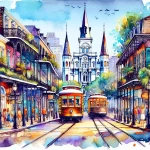Tennessee Williams’ literary masterpieces have become an integral part of New Orleans’ identity. His plays, novels, and short stories encapsulated the city’s essence and immortalized its captivating spirit, making it a vital component of his artistic vision.
In This Article
TL;DR
- New Orleans’ bohemian ambiance inspired Williams and shaped his creative perspective.
- His renowned play “A Streetcar Named Desire” captured the city’s vivacious spirit.
- Williams’ works celebrate the city’s diverse cultures and contribute to preserving its literary heritage.
A Bohemian Muse
New Orleans was more than just a backdrop for Williams; it was a source of inspiration that molded his artistic sensibilities. Upon his first visit in 1938, he was captivated by the city’s bohemian atmosphere, writing in his journal, “Here surely is the place I was made for, if any place on this funny old world.” The French Quarter, with its narrow streets and courtyards, provided a stark contrast to his puritanical upbringing, allowing him to explore his identity and embrace his authentic self.
A Streetcar Named Desire: Immortalizing the City’s Spirit
Williams’ most celebrated work, “A Streetcar Named Desire,” is a testament to his love for New Orleans. Set in the city’s iconic French Quarter, the play captures the raw emotions, societal tensions, and cultural complexities that defined the city in the 1940s. The characters, from the fragile Blanche DuBois to the brutish Stanley Kowalski, embody the contrasting forces that collide in the city’s melting pot of cultures and social classes.
The play’s vivid descriptions transport readers to the heart of New Orleans, where the air is “heavy with the scent of jasmine and oleanders.” Williams’ attention to detail, from the architecture to the local dialects, creates an immersive experience that celebrates the city’s unique character.
A Literary Legacy
Beyond “A Streetcar Named Desire,” Williams’ other works, such as “Vieux Carré” and “The Rose Tattoo,” also draw inspiration from the city’s diverse tapestry of cultures and traditions. His characters often reflect the diverse ethnic backgrounds that make up New Orleans, including African American, Creole, and immigrant communities.
Williams’ impact on the city’s literary scene is celebrated annually at the Tennessee Williams New Orleans Literary Festival (TWFest). This four-day event, held in the historic French Quarter, features writer’s craft sessions, literary panels, theatrical performances, and special events that pay homage to the playwright’s enduring legacy.
One of the festival’s highlights is the iconic Stella Shouting Contest, where participants reenact Stanley Kowalski’s famous call for his wife, Stella. This lighthearted event not only celebrates Williams’ most iconic work but also serves as a fundraiser for the New Orleans Family Justice Center, underscoring the festival’s commitment to community engagement.
Exploring the City’s Literary Landscape
For those seeking to immerse themselves in Williams’ New Orleans, several walking tours and exhibitions offer a glimpse into the playwright’s life and work. The Historic New Orleans Collection’s “Backstage at A Streetcar Named Desire” exhibition provides a behind-the-scenes look at the play’s production, featuring costumes, set designs, and other artifacts.
Additionally, guided walking tours take visitors through the French Quarter, highlighting the locations that inspired Williams’ iconic works. These tours offer a unique opportunity to experience the city through the lens of one of its most celebrated literary figures.
Tennessee Williams’ literary legacy is deeply intertwined with the cultural fabric of New Orleans. His works not only immortalized the city’s vivacious spirit but also served as a catalyst for celebrating its rich literary heritage. Whether through attending the annual festival, exploring exhibitions, or simply wandering the streets that inspired his masterpieces, visitors can immerse themselves in the enduring legacy of this literary giant and the city that captured his heart and imagination.






